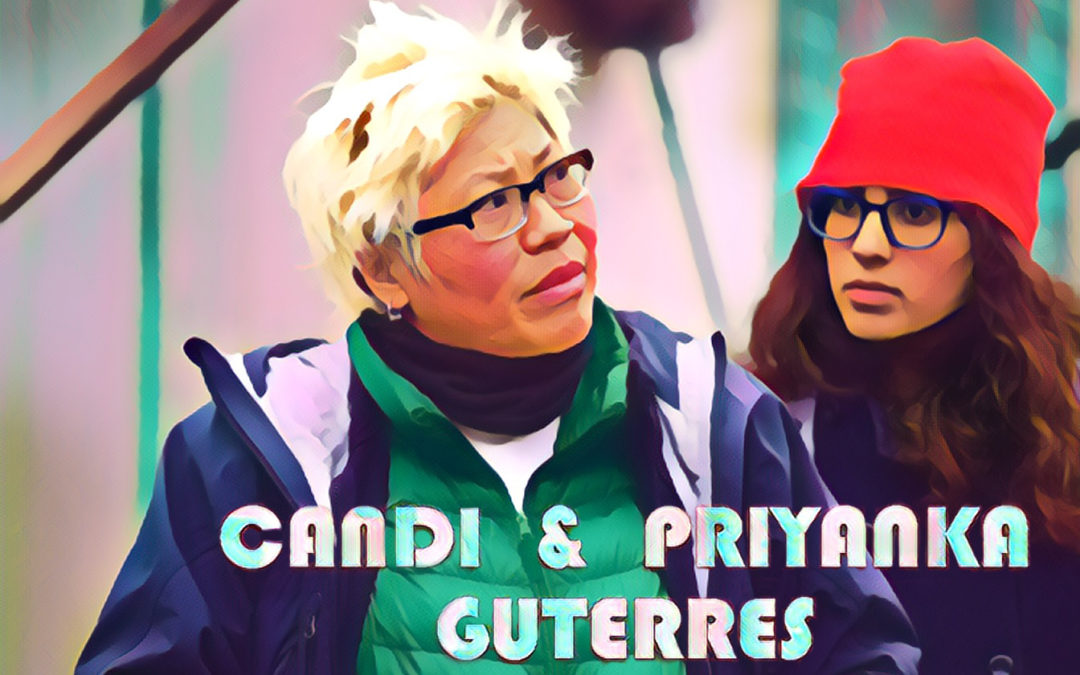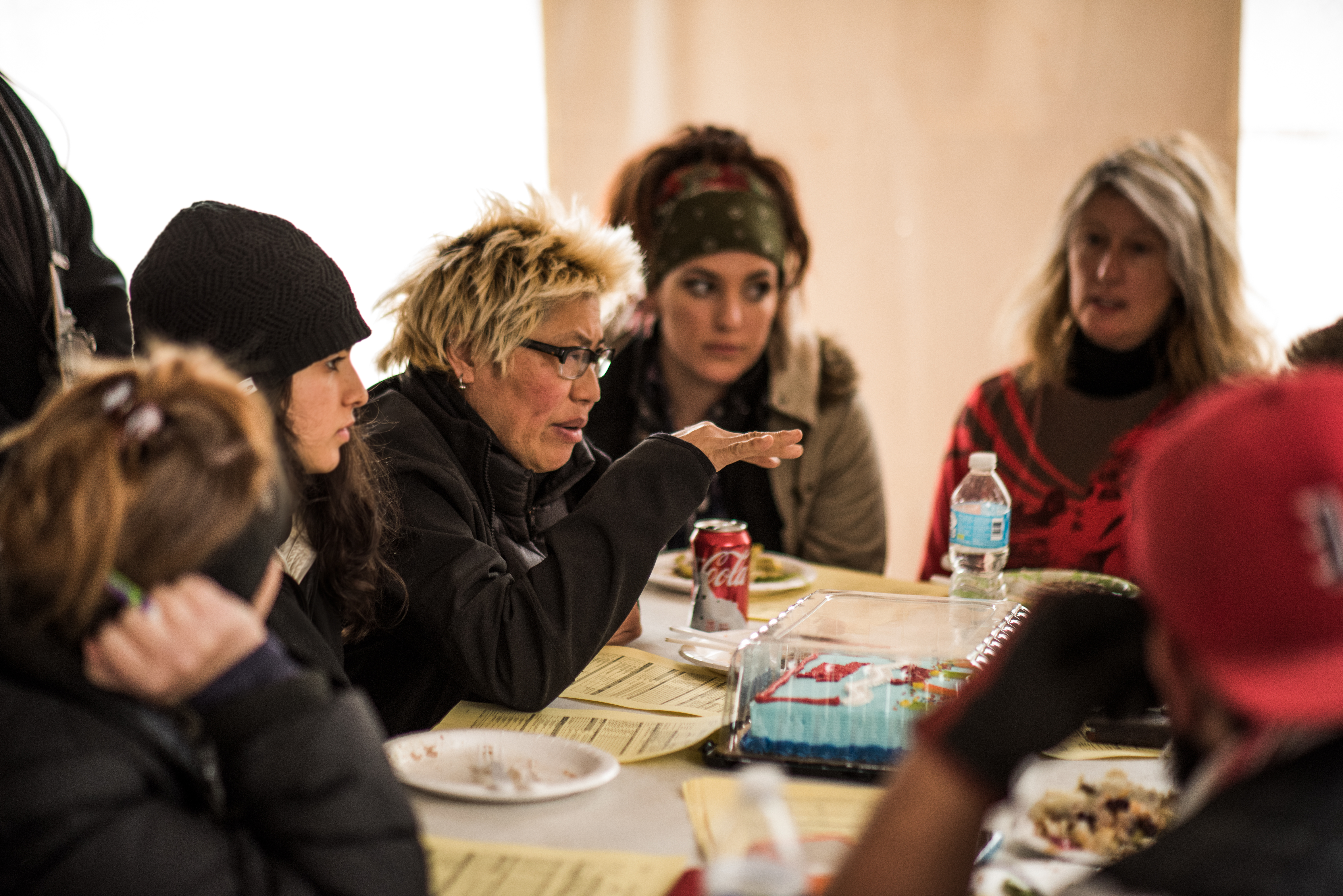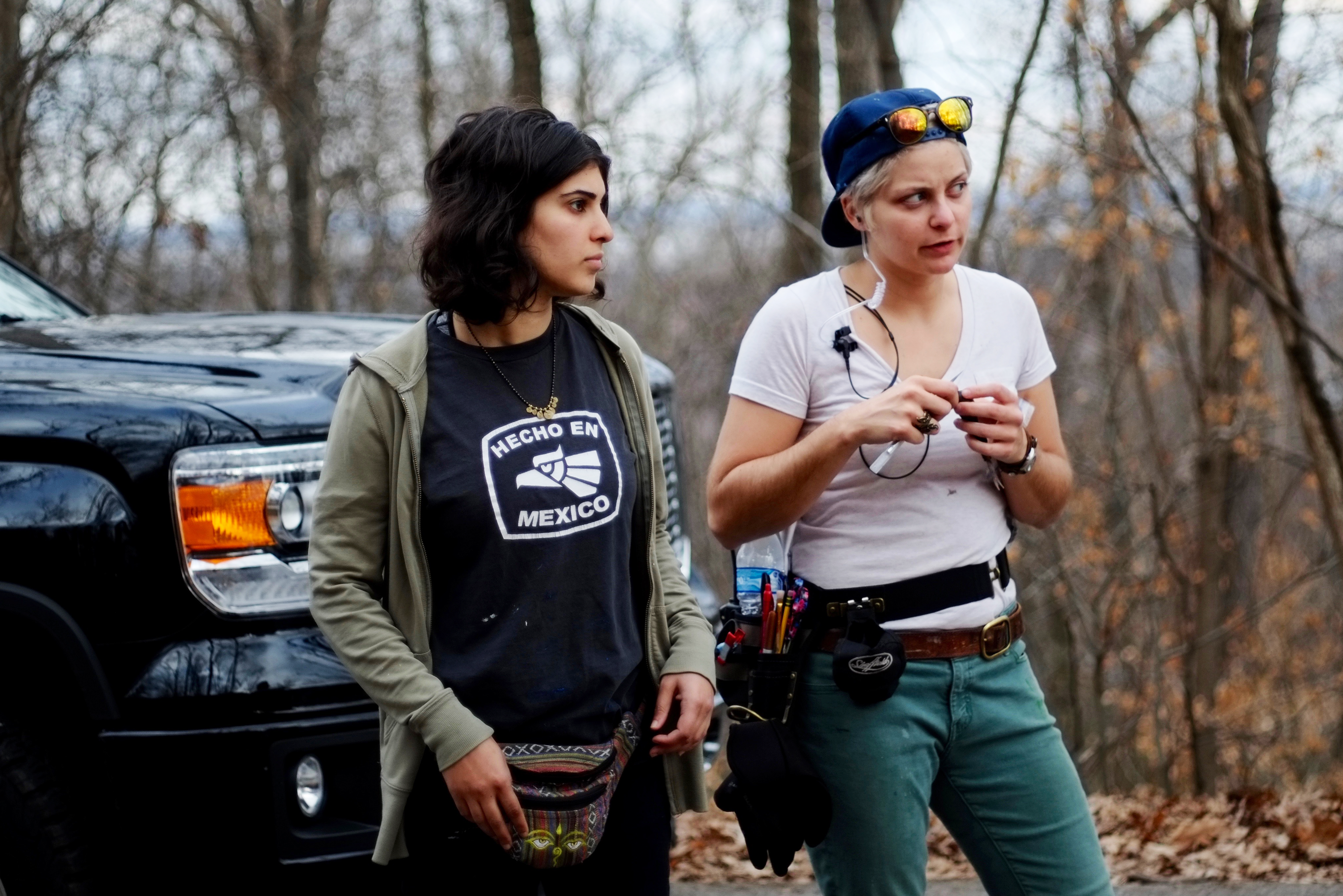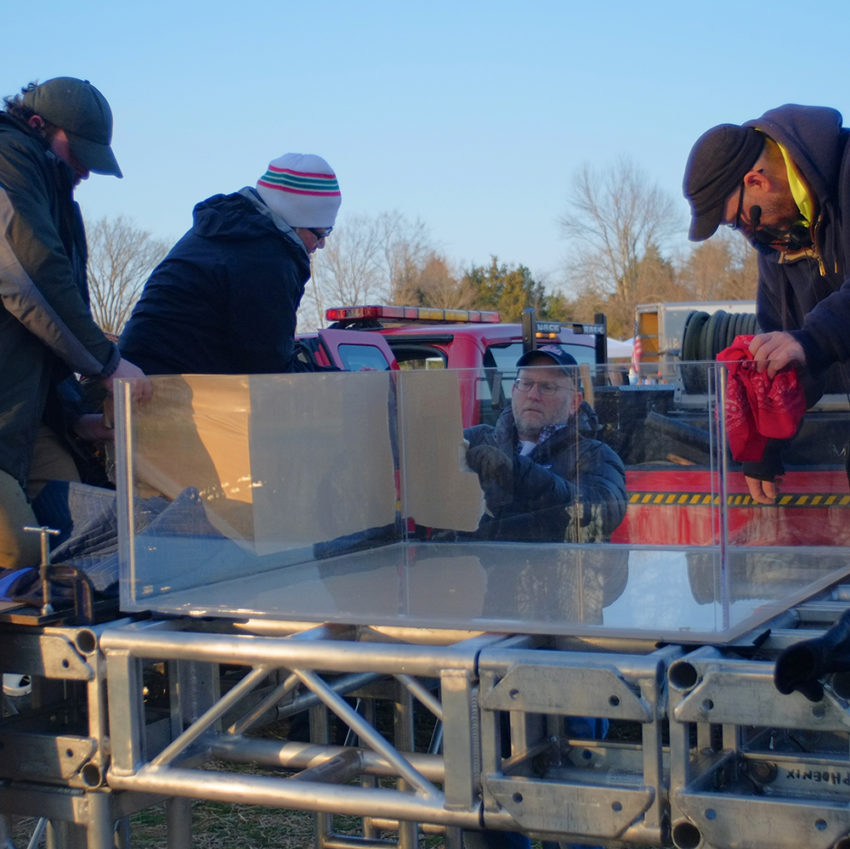About Candi and Priyanka Guterres
Candi and Priyanka Guterres are a production designer / set decorator team that created the world of Rust Creek. Candi’s work experience spans from Asia, Russia, Iceland, Mexico, and the Peruvian Amazon, from period films to sci-fi fantasy. Recent projects include Lunacy Production’s Rust Creek, Stargate Origins (MGM), Pillbox, the latest visual album by Billy Corgan, and the film content tour visuals for the Smashing Pumpkins’ 2018 SOSB Tour.
Lunacy Productions: What were your roles on Rust Creek?
Candi Guterres: I was the production designer on Rust Creek. Priyanka was the art director and set decorator.
LP: How did you get involved with the film?
CG: It was through the recommendation of a mutual friend that knew the director, Jen McGowan. We heard that Jen was a great director to work with. I met with Jen, found out the story was female-driven, and we got along really well, so we decided to embark on this adventurous journey to Kentucky.
Priyanka Guterres: Kentucky in the winter, which is the big keyword.
LP: Yeah, the temperature often got down into single digits. How did you handle the weather challenges during production?
PG: It was my first experience in this extreme winter weather. Being a native Californian, it was certainly a challenge. There were times where your fingers would freeze up, making it very difficult to make adjustments on set. But we embraced it, knowing that we were all in it together.
CG: Preparation is one of the biggest components in art department. There are tricks to dressing for the extreme cold weather. You have to prepare and layer up. I spent some time filming in Russia and in Iceland before Rust Creek, so I had experience working in snow and up in the glaciers under extreme conditions, which helped.
LP: What was it like to film in Russia? How did that prepare you for other films you’ve worked on with weather challenges?
CG: I filmed in Russia in the late 90s, on the film Anna Karenina, directed by Bernard Rose, under Academy Award winning Production Designer John Myhre. We were there in the late summer, during white nights, where it’s 24-hrs of daylight and never gets dark. Actually, both times that I was in Russia and in Iceland, it was during white nights, going into Fall.
It was exceptional. They were completely different projects. They were studio films, so they had a different set of challenges. In Russia, I was in charge of props, animals, and trains. We shot in a lot of palaces and I had to procure a lot of props from museums given the period (late 1800s). As for animals, there were wolves, rats, bees, horses, birds, dogs, an ice-skating monkey, and an 8-foot Siberian brown bear. Fun!
In one of the scenes, there is a quail hunt. I found some quails locally, but since they didn’t fly we ended up bringing in 50 pheasants from Ireland to fake the scene. Today, I’m hoping there’s a healthy pheasant population in Russia, thanks to the movie. I’m keeping my fingers crossed on that one.
Candi Guterres addresses the other department heads during a crew meeting for Rust Creek.
LP: That’s incredible.
CG: It was definitely cold. I remember, we had just finished shooting a scene in the Neva River, and it was frozen over. As I was gathering all the props, ice skates and sleighs, I started to hear the ice cracking. I hurried off with all the props to safety, by the side of the river. Sure enough, not soon after a boat came by cracking the ice.
That’s become one of my favorite things to do, actually. To do movies that are challenging not only on a subject matter or story level, but to travel and work overseas. I love a challenge under extreme conditions.
LP: Kentucky isn’t overseas, but the conditions were pretty extreme. What was it like working there?
PG: Shooting Rust Creek was one of my most memorable experiences working in the film industry. It was great! The hospitality in Kentucky is truly remarkable, and everybody made you feel at home and comfortable. Most of our creative team was female. It really was a fun dynamic. It wasn’t a struggle to communicate; it was organic and seamless. And we had fun while doing it!
CG: I think one of the greatest things about the project is that it was female-driven. It was a story about empowerment. That is what really drove us to work with Jen on Rust Creek.
And Kentucky turned out to be such a gem, especially Louisville. It’s such a great little town. We now regularly go back and shoot projects in Louisville because of our experience on Rust Creek. We’ve been there four times and have worked on several different shows and series. The people are great, and we have a lot of fun there.
LP: How did Jen’s directing style contribute to the synergy that you guys felt on set?
CG: Jen was very focused and prepared. It’s an ambitious project, character driven, with some pyrotechnics and explosions, set against the Appalachian backdrop in the dead of winter; a passion project with an indie budget, so prep was of the essence. We shared documents with the creative team: Jen, Michelle Lawler (DP), Alexis Scott (costume designer), and ourselves. I think active communication between departments is extremely important when you’re creating a look and a tone for the story. We all worked very hard to stay synchronized, sharing the same vision. Jen has a very hands-on approach and is a great leader.
PG: Jen is a director who knows what she wants. She’s also open for discussion if you have ideas. There’s flexibility. She pushes you to improve on your ideas. She is really committed to telling the best story.
Priyanka Guterres (left) consults with prop master Katie Blackburn on the set of Rust Creek.
LP: What was it like working with Stu? How did his connections in Kentucky help your team?
CG: On an indie-budget project, you need to have someone well-connected and well-liked like Stu leading the way. He knows everybody in Kentucky, which was very helpful. Little surprises came in that way. If we had trouble finding certain items, we’d say, “Hey, let’s ask Stu.” The next thing you know, things would just appear on set. If Stu himself could not make it happen, he would connect us to somebody in the community that could help us. Or, we would have to build it.
PG: In Kentucky, there are no prop houses. So if we needed something specific, we would either ship it out from L.A. or from other out-of-state prop houses. We also did a lot of antique shopping at the Peddler’s Malls, and borrowed from locals. People would just voluntarily loan us things that we would need. It was amazing. It’s a huge contrast to shooting in a major city like Los Angeles.
LP: What were some of the biggest challenges that you faced on Rust Creek?
CG: One of the challenges was to create sets in the Louisville area that needed to look very remote, because most of the story takes place in the woods. For example, we turned an old electronics store into the Sheriff’s Station. We added wood paneling and brought in pine trees to place outside the windows to make it look like it was in a more remote area. We built a tie-in wall and used paint to help “cheat” the Interior Sheriff Station in one location, to match a different location that we were using for the Exterior Sheriff Station.
LP: How did you decide on the look of the sets and locations in the film to reflect the mood and story?
CG: Early on we created a distinctive color palette, inspired by the film’s title and its setting in nature, highlighted by cool and warm tones which defined the different characters. We created a timeline that matched the story. We had a mood board, depicting inspiration photos, research images of different trailers, meth labs—our color palette, the characters. We basically created the visual look of the story on the wall.
PG: We had an ample space in the Production Office where we had meetings with our team. As we secured different set dressing items, we would replace our research photos with the actual photos of the set dressing and props we had found. It was important that the sets looked realistic and lived-in. From the business cards and stacks of paperwork on the desks in the interior of the Sheriff’s Station, to the intricate details of the home-made meth lab in Lowell’s Trailer. We even brought on a “meth consultant” from the local Sheriff’s office to help us fine tune those details and to bring authenticity to the environment.
LP: What else stuck out to you from your experience on Rust Creek?
CG: For me, one of the fun design moments during the film was figuring out the logistics for these two underwater camera shots we needed to get without actually going into the creek. During the final fight scene, an actor gets their head dunked in the water. Jen and Michelle wanted to shoot several underwater shots of the actor pretending to struggle for breath, as well as an insert of a weapon floating to the bottom of the riverbed. So we decided to build a big acrylic water tank and transport it to the woods to match the river location. It was a challenge but it worked.
We created a truss substructure for the water tank to sit on. It had a platform for the actors to rest on top and a place for the camera underneath. We had to heat the water because it was very cold when we were filming those scenes. We placed leaves in the tank and set up a pump to keep the water running and the leaves moving to give it that dynamic feel of a creek. This way the camera was able to shoot from underneath for the drowning scene and from the side for the “weapon reveal.”
LP: Can you expand on why the film’s female-focused story resonated so much for you?
CG: I choose my projects based on the people that I’m working with, the subject matter, and of course, the story being very relevant in today’s world.
PG: In Rust Creek, Sawyer, the main character, takes a wrong turn and meets these suspicious characters. It’s such a real scenario. It could easily happen to anyone. She pulls over on the side of the road, and two guys stop and approach her, and it’s that tense-building moment of… well, they haven’t really crossed the line yet… until, they do. And how do you protect yourself from that?
It’s really empowering to see a female fight for herself, kick butt, and survive. I think it’s about time for more stories like that. She had no help, and single-handedly is able to get out of the situation, but at the same time, she’s not a superhero. It’s very realistic.
LP: What advice would you have for filmmakers who want to work on female-focused films storylines? How do you find those projects? How can you help those projects move forward?
CG: Go and make your movies. We need the female voice being heard, especially now.
Most of my projects come from word-of-mouth and established relationships. It’s also about harvesting new relationships and being open. I have a good group of female filmmakers that I’m friends with, and I’m always open to those kind of stories. I’ve been very lucky.
PG: Also, when you have strong beliefs of how you see the world, you have a network of others who view the world in a similar way. As filmmakers, it’s such a treat to be able to join forces to tell that story. I think the strength is knowing what your voice is and teaming up with others who share that similar point of view.
Then the passion behind the film is there. It’s the intention. It’s not just a movie to make some numbers in the box office. It’s a story for a reason, telling a narrative to inspire the audience or to empower them. I think that’s an important factor.
LP: Thank you so much for your time. We really appreciate it.
Candi and Priyanka Guterres‘s latest film, Rust Creek, is in theatres and on VOD platforms now! Check it out today, and keep reading the Lunacy Productions Blog for more info on the film!




